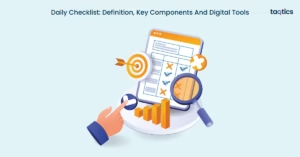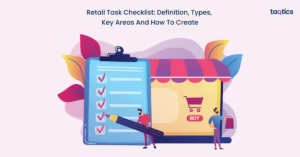Retail Asset Lifecycle Management: Overview, Benefits, Stages, Tools, Challenges
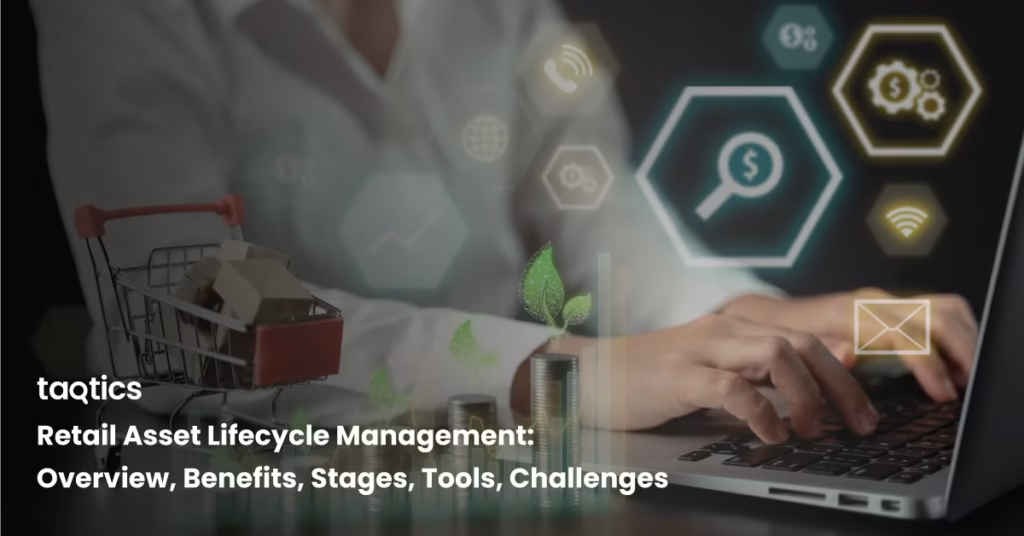
Asset Lifecycle Management (ALM) is a critical component of efficient retail operations, helping businesses manage the complete journey of physical assets, from acquisition to disposal. With retail businesses operating across multiple locations and managing thousands of assets, ALM ensures that each asset is tracked, maintained, and optimized for maximum performance. According to a McKinsey report, retailers that implement structured ALM practices can reduce maintenance costs by up to 30% and extend asset life by 20%.
In the fast-paced retail environment, poorly managed assets can lead to increased downtime, inconsistent customer experiences, and higher operational costs. For instance, a malfunctioning POS system or refrigeration unit can immediately impact sales and product quality. Effective ALM minimizes such disruptions through proactive maintenance, real-time tracking, and strategic planning.
Additionally, ALM supports compliance, sustainability goals, and budget forecasting—areas increasingly important in today’s retail landscape. As consumer expectations grow, ALM ensures stores maintain a consistent brand image and operational reliability across all locations.
Retailers leveraging digital ALM tools are better equipped to make data-driven decisions, optimize capital investments, and stay agile in a competitive market. Ultimately, ALM not only protects asset value but also enhances customer satisfaction and operational efficiency.
What is Asset Lifecycle Management (ALM)?
Asset Lifecycle Management (ALM) is a strategic approach to managing physical assets, such as machinery, vehicles, IT equipment, or infrastructure, through every stage of their life, starting from planning, acquisition, deployment, maintenance, to disposal or renewal. Asset Lifecycle Management’s goal is to maximize the value an asset provides while minimizing costs, risks, and downtime throughout its lifespan.
The ALM process typically includes the following phases: planning and budgeting, procurement, installation and operation, performance monitoring, maintenance, and end-of-life management (such as resale, recycling, or decommissioning). Effective ALM ensures assets are used efficiently, remain compliant with regulations, and support long-term business goals.
For example, a public transportation agency purchases a fleet of buses. ALM would involve selecting the right models, scheduling regular maintenance to keep them running safely, tracking fuel efficiency and repair costs, and eventually deciding when to refurbish or replace them. Data gathered throughout the lifecycle helps in making informed decisions and improving future investments.
By using ALM practices, organizations can extend asset life, reduce operational costs, and improve reliability. It also enables better forecasting and strategic planning, especially when combined with asset management software that provides real-time data and analytics.
What are the Key Benefits of Asset Lifecycle Management?
The key benefits of asset lifecycle management include optimized asset utilization, cost control, improved store operations, better capital planning, consistent brand experience, regulatory compliance, sustainability initiatives, and data-driven decisions.
- Optimized Asset Utilization: Ensures retail equipment and infrastructure are used efficiently across all locations, avoiding over- or under-use.
- Cost Control: Tracks asset performance and maintenance needs to reduce unexpected repairs, extend asset life, and lower total cost of ownership.
- Improved Store Operations: Minimizes downtime of critical equipment like POS systems or refrigeration, ensuring smooth customer service and product preservation.
- Better Capital Planning: Helps retailers forecast when to repair, upgrade, or replace assets, supporting more strategic budgeting and investment.
- Consistent Brand Experience: Maintains uniformity in store appearance and functionality by managing fixtures and displays across locations.
- Regulatory Compliance: Ensures assets meet health, safety, and environmental regulations, which are especially important for food and consumer safety.
- Sustainability Initiatives: Promotes responsible asset disposal and energy-efficient upgrades, aligning with corporate sustainability goals.
- Data-Driven Decisions: Provides insights from asset data to support smarter purchasing, maintenance, and operational decisions.
In retail, ALM focuses on managing physical assets such as store fixtures, POS systems, lighting, refrigeration units, and digital displays. Effective ALM in retail helps streamline operations, reduce costs, and enhance the customer experience.
What are The Stages of the Retail Asset Lifecycle?
The stages of the retail asset lifecycle ensure assets are efficiently managed from purchase to end-of-life.
Planning & Acquisition
This stage involves identifying asset needs based on store layout, operations, and customer experience goals. Retailers evaluate cost, functionality, and compatibility with existing systems. Strategic planning ensures the right assets—like shelving, POS systems, or digital displays—are selected within budget and aligned with brand standards.
Deployment & Utilization
After acquisition, assets are installed and integrated into store operations. Effective deployment includes proper setup, staff training, and usage tracking. During this phase, retailers monitor how assets support day-to-day operations and enhance customer experience, ensuring maximum utilization.
Maintenance & Optimization
Regular inspections and preventive maintenance are conducted to avoid breakdowns and prolong asset life. Performance data is analyzed to identify inefficiencies or underperforming assets. Optimization may involve software updates, layout changes, or reallocation to different locations.
Decommissioning & Disposal
Once an asset reaches the end of its useful life, it is safely removed. Retailers may sell, recycle, or dispose of assets in compliance with environmental regulations. Data from this stage informs future planning and purchasing decisions.
This lifecycle approach ensures assets remain reliable, cost-effective, and aligned with business goals.
What are The Types of Assets in Retail?
The types of assets in retail are fixed assets, technological assets, inventory assets, digital assets, and mobile and promotional assets.
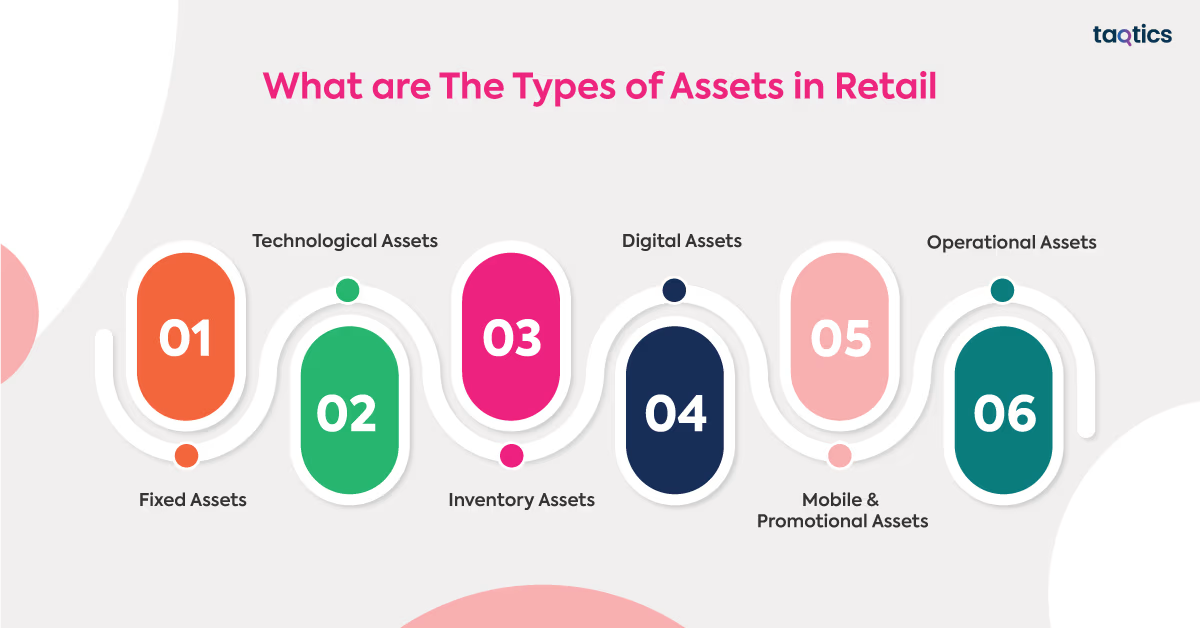
- Fixed Assets: Long-term physical assets used to run retail stores. These are not sold to customers but support operations. Some examples include store fixtures, shelving, lighting systems, and HVAC units.
- Technological Assets: Digital and electronic tools used for transactions, security, and data management. POS systems, barcode scanners, surveillance cameras, and IT hardware are a few examples that fall under this category.
- Inventory Assets: Products or goods held for resale to customers. These are central to revenue generation. For example, Apparel, electronics, food items, and seasonal goods.
- Digital Assets: Intangible assets that support online presence, marketing, and customer engagement. Examples include E-commerce platforms, loyalty program data, mobile apps, and digital content.
- Mobile & Promotional Assets: Moveable or temporary assets used for advertising or seasonal displays. Signage, display stands, mannequins, and kiosks are some examples.
- Operational Assets: Equipment and tools used in store operations, logistics, or warehousing. For example, pallet jacks, delivery vehicles, storage bins, and cleaning equipment.
Effective management of these asset types enhances efficiency, reduces costs, and improves customer experience in retail environments.
What Tools are Necessary for Asset Lifecycle Management?
Tools like Taqtics are necessary for asset lifecycle management (ALM) in retail offer speciliaized features that track, maintain, and optimize assets throughout their lifespan.
- Real-Time Asset Tracking: Monitor physical and digital assets, such as refrigerators, mannequins, and devices, to ensure timely maintenance and avoid unexpected breakdowns.
- Automated License Management: Receive automated reminders for license renewals, ensuring compliance with legal and regulatory requirements and avoiding penalties from expired licenses.
- Bulk Asset Creation: Easily add and manage multiple assets simultaneously, simplifying the tracking of a large number of items across various locations.
- Barcode Integration: Utilize barcode technology for fast and simple asset tracking, enhancing efficiency in monitoring assets across different locations.
- Automated Reporting: Generate automated reports to assess asset performance, identify maintenance needs, and make informed decisions on resource utilization.
By integrating Taqtics into retail operations, businesses can streamline asset management processes, reduce downtime, and ensure compliance, ultimately enhancing overall operational efficiency.
KPIs to Measure ALM Effectiveness
There are 5 KPIs to measure ALM effectiveness, which include asset utilization rate, TCO, maintenance compliance rate, asset downtime and repair frequency, and depreciation tracking accuracy.
- Asset Utilization Rate: This measures how effectively assets are used over time. High utilization indicates efficient use, while low rates may reveal underused or idle assets, suggesting a need for reassignment or disposal.
- Total Cost of Ownership (TCO): TCO includes purchase price, installation, maintenance, operation, and disposal costs. Monitoring TCO helps retailers evaluate asset profitability and optimize procurement decisions.
- Maintenance Compliance Rate: This KPI tracks adherence to scheduled maintenance. High compliance ensures assets are serviced regularly, reducing unexpected breakdowns and extending asset life.
- Asset Downtime and Repair Frequency: Frequent repairs and prolonged downtimes signal unreliable assets, affecting operational efficiency. Monitoring this helps identify candidates for replacement or redesign.
- Depreciation Tracking Accuracy: Accurate depreciation tracking is crucial for financial reporting and forecasting. It ensures asset values reflect real-time conditions, supporting informed budgeting and replacement planning.
These KPIs provide a comprehensive view of retail ALM performance, enabling data-driven decisions to maximize asset value and minimize lifecycle costs.
What are the Challenges in Retail Asset Lifecycle Management?
Retail Asset Lifecycle Management (ALM) faces several challenges that can hinder efficiency and cost control:
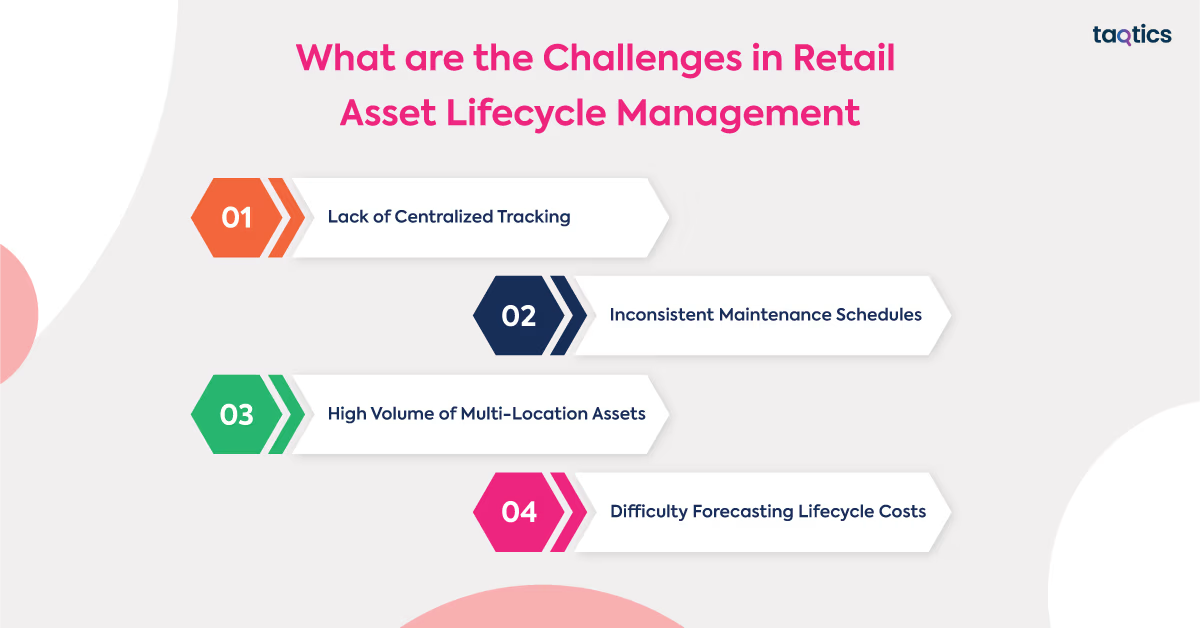
Lack of Centralized Tracking
Without a unified system, tracking assets across departments or locations becomes fragmented. This leads to duplication, loss, or underutilization of assets, making it difficult to manage inventory and plan replacements effectively.
Inconsistent Maintenance Schedules
In retail, varying schedules across locations often result in missed or delayed maintenance. This inconsistency increases the risk of asset failure, shortens asset lifespan, and raises emergency repair costs.
High Volume of Multi-Location Assets
Retailers often operate numerous stores, each with a wide range of assets. Managing this complexity manually is inefficient and error-prone. It becomes difficult to maintain visibility, ensure standardization, and enforce company-wide ALM policies.
Difficulty Forecasting Lifecycle Costs
Accurately predicting costs over an asset’s lifecycle requires reliable data on usage, maintenance, and performance. Without robust historical data and analytics, budgeting for replacements, upgrades, or maintenance becomes guesswork, leading to overspending or unexpected costs.
Addressing these challenges requires integrated systems, automated workflows, and data-driven strategies to optimize asset performance and control costs across the retail network.

